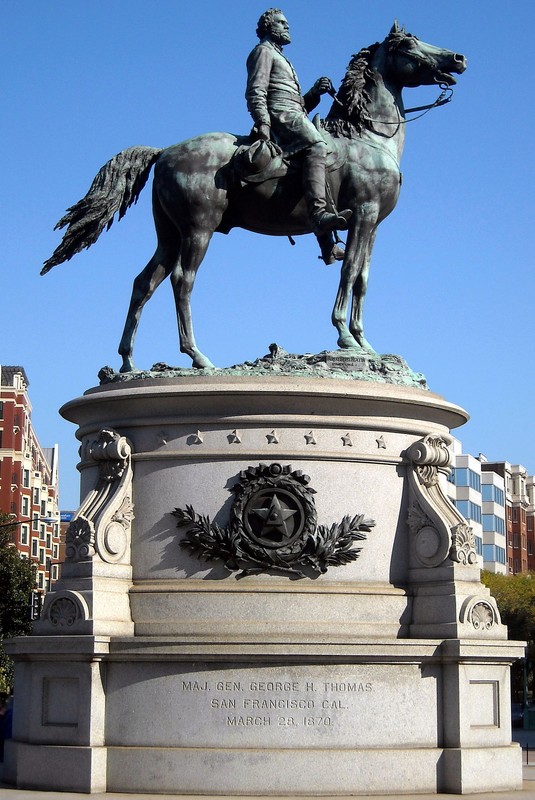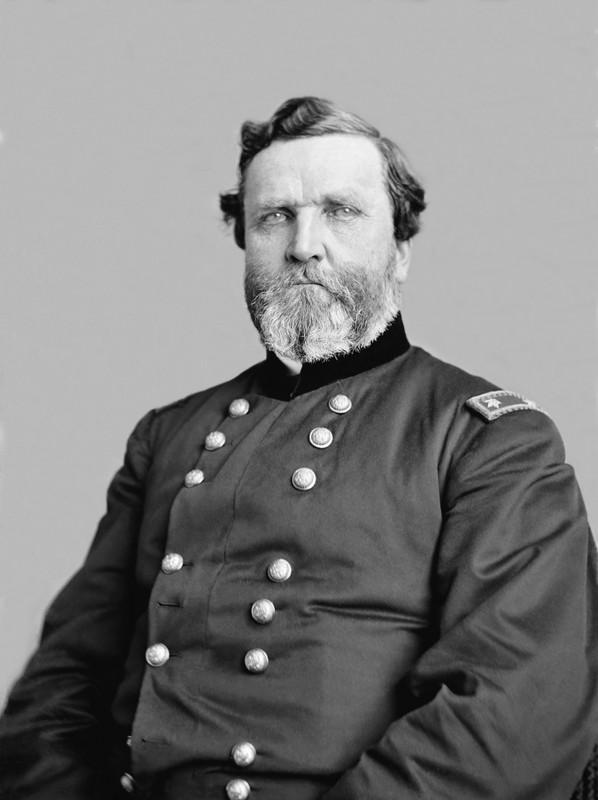Major General George H. Thomas Memorial
Introduction
Text-to-speech Audio
Images
Major General George H. Thomas Memorial in Thomas Circle Park in Washington, D.C.

A closer look at the bronze sculpture designed by John Quincy Adams Ward
.jpg)
George H. Thomas (1816-1870)

Backstory and Context
Text-to-speech Audio
George Henry Thomas was born into wealth and privilege on his family’s planation just a handful of miles from the North Carolina border in Southampton County, Virginia on July 31, 1816. His early years, however, were beset by tragedy and trauma. When Thomas was thirteen years old, his father died in a farming accident. Two years later, he and his family barely escaped with their lives during Nat Turner’s insurrection, the bloodiest slave uprising in American history. At the age of twenty, Thomas secured a spot at the United States Military Academy at West Point. During his time there, due to his age, his younger classmates gave him the nickname “Old Tom.” After graduating in the top third of his class in 1840, Thomas received a commission as a second lieutenant in Company D, Third U.S. Artillery. In subsequent years, he served in the Second Seminole War and, like many future Civil War commanders, the Mexican War. Thomas then returned to West Point after being appointed an instructor of artillery and cavalry.
When the Civil War broke out and his native state of Virginia seceded from the Union in the spring of 1861, Thomas remained loyal to the United States and refused to resign his commission in the U.S. Army, despite being offered several military commissions from the Confederacy. His decision not only angered his family, but also drew the ire of some of his colleagues and former students at West Point. One such former pupil, J.E.B. Stuart, confessed in a letter to his wife that he would like to hang Thomas as a traitor to the Old Dominion.
In January 1862, while leading a Union force in Kentucky, Thomas score the Union’s first significant victory in the west at the Battle of Mill Springs. The following year, while anchoring the Union left at the Battle of Chickamauga, he prevented a federal rout after Confederate forces broke through Union lines. During the chaos, Thomas hastily organized a defensive stand and held his position despite withering Confederate assaults until reserve units arrived and enabled an orderly federal withdrawal to Chattanooga. For his heroics, he received a promotion to the rank of brigadier general, assumed command of the Army of the Cumberland, and earned the nickname the “Rock of Chickamauga.” In December 1864, Thomas nearly destroyed Confederate General John Bell Hood’s Army of Tennessee at the Battle of Nashville. In the aftermath of the engagement, he received the thanks of Congress and a promotion to the rank of major general.
Following the war, Thomas commanded the Department of the Cumberland until 1869. That year, he took command of the Department of the Pacific and relocated to its headquarters in San Francisco. On March 28, 1870, Thomas died there of a stroke. He was fifty-three years old.
Shortly after Thomas’s death, at the fourth reunion of the Society of the Army of the Cumberland, members voted to erect a memorial in honor of their beloved commander. The Union veterans’ organization appointed a committee in each state to help raise funds for the project. Within a few years, these committees had raised a total of $10,000. With fundraising going well, the society petitioned Congress for decommissioned cannons, the metal from which would be used in the making of the memorial. Congress granted the request, sending eighty-eight old bronze cannons. Later, it also appropriating $25,000 for the memorial’s pedestal. The Society of the Army of the Cumberland then commissioned up-and-coming New York sculptor John Quincy Adams Ward to design a fourteen-foot-tall bronze equestrian statue of Thomas. Ward completed the plaster model by the spring of 1879 and on November 19 the finished product was unveiled in the nation’s capital. Present at the dedication ceremony, in addition to a crowd of an estimated 50,000 spectators, were President Rutherford B. Hayes, his cabinet, innumerable members of Congress, officers of the Society of the Army of the Cumberland, and the artist himself.
Sources
"George H. Thomas." Encyclopædia Britannica. 24 March 2021. Web. 16 April 2021 <https://www.britannica.com/biography/George-H-Thomas>.
"George Thomas." battlefields.org. American Battlefield Trust. Web. 16 April 2021 <https://www.battlefields.org/learn/biographies/george-thomas>.
Jacob, Kathryn Allamong. Testament to Union: Civil War Monuments in Washington, D.C. Baltimore: The Johns Hopkins University Press, 1998.
"Major General George H. Thomas Memorial." NPS.gov. U.S. Department of the Interior. 27 October 2020. Web. 16 April 2021 <https://www.nps.gov/places/000/major-general-george-h-thomas-memorial.htm>.
Wright, John D. The Routledge Encyclopedia of Civil War Era Biographies. New York: Routledge, 2013.
https://en.wikipedia.org/wiki/Equestrian_statue_of_George_Henry_Thomas
https://commons.wikimedia.org/wiki/File:Major_General_George_H._Thomas_(14132585).jpg
https://en.wikipedia.org/wiki/George_Henry_Thomas
